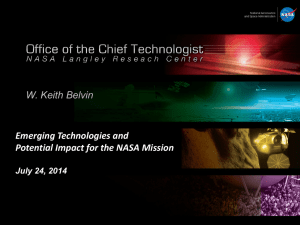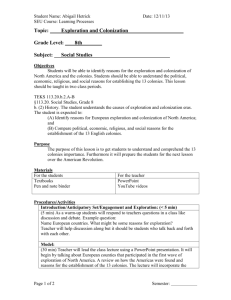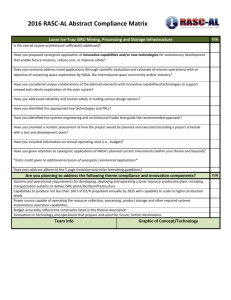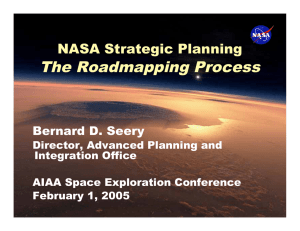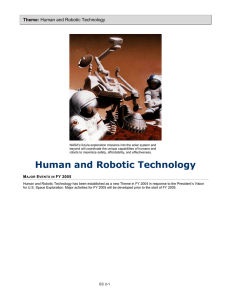Space Exploration to Colonization
advertisement
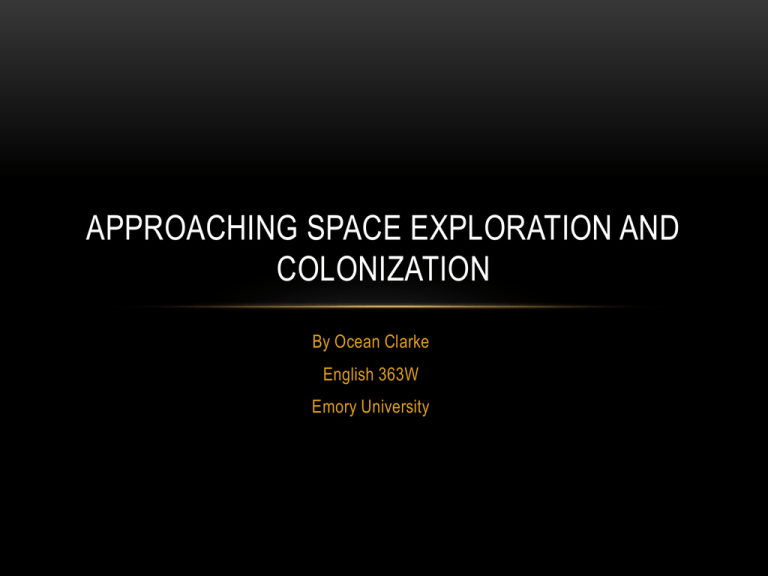
APPROACHING SPACE EXPLORATION AND COLONIZATION By Ocean Clarke English 363W Emory University INFOGRAPH • This infograph provides information the current state of space exploration. It sheds lights on the outreach of manned space flights as well the public’s opinion of outer space and it also provides pros and cons of human and robot space exploration. • https://magic.piktochart.com/output/5288661-efficiencyspace-exploration THE CONSTELLATION PROGRAM • This program was created by George Bush and NASA in order revitalize the public’s interest in space exploration. • Public interest reaches peaks whenever humans are involved directly. • The main goals of this program were to • Design new rockets • Examine effects of outer space on the human body • Explore the Moon and potential for colonization • Explore Mars • However this program was cancelled in 2009 for being over schedule and behind. ADDRESSING COMMON OBJECTIONS TO MANNED SPACE FLIGHT • People have raised objections that space colonization is too technically challenging. They question whether we should relocate funds into NASA or if humanity is even meant to explore and live in outer space. • By labeling something as too technically challenging, we downplay the potential of human imagination. People serious about space colonization understand that the process will be a slow and incremental but well worth it. Species regularly adapt to new spaces and that is something we can do. By understanding the effects of space on the human body, we will be able to develop something to negate these effects. • Also a relocation of funds implies that an infusion of money can solve our basic human problems and that is not the case. If we aim for solutions on Earth, we need culture change and not financial. NASA’S BUDGET AND VALUE • At the height of all excitement of the Moon landing, NASA’s budget was a little less than 5% of the federal budget and that is the highest it has ever been. • Since then the budget has lingered around 1% • Today, NASA’s budget is 0.5%. • According to the Gallup Polls, a majority of Americans believe the space program has brought enough benefits to justify its costs. • The polls also revealed that a majority of Americans believe NASA is doing a good job. • Although the human approach is more expensive than the robotic approach, the human approach is also more efficient in planetary exploration. SIGNIFICANCE OF REINCORPORATING MANNED SPACE FLIGHT • “If one is considering the future of the human race, we have to go [into outer space] ourselves … If the human race is to continue for another million years, we will have to boldly go where no one has gone before” – Stephen Hawking • The outreach of manned space flight has the potential to influence interests and educational decisions of parents and children, especially towards the field of science. • Manned space flights can also directly and indirectly create significant commercial opportunities. • Sending humans into outer space will also provide new knowledge to fundamental questions regarding the creation of our universe and the life within. COOPERATION AND COLONIZATION • Examples of different combinations of human and robot: • Machines can perform terrain-based and aerial reconnaissance. This information can help humans plan exploration routes and locate certain targets. However, the information relayed is not in real time thus it will take a while for information to reach humans. • The robotic ‘mule.’ This machine can carry various items and perform routine and repetitive tasks with ease however it must be within very close proximity to humans. • The telerobotic approach is a combination of human and robot which allows humans to control robots from a distance however it requires a high-fidelity, high-bandwidth connection so the physical distance between robot and human can’t be too far. Teleoperated robots allow humans to remain in a habitat and see exactly what a robot sees while also being able to control the machine in sharp detail. This approach can also give humans extra abilities versus if they were exploring by themselves. CONCLUSION: THE MOST EFFECTIVE APPROACH • For reasons of safety, effectiveness, and efficiency, the telerobotic approach is ideal for space exploration and colonization. We do not need to walk every step with our robots and risk endangering our lives nor do we need them traveling so far ahead that it limits effectiveness drastically. With this approach we will effectively be able to gain valuable knowledge to fundamental questions we have as human beings, regarding life. DATA DATA (CONT.) DATA (CONT.) SOURCES • http://www.nasa.gov/pdf/55583main_vision_space_exploration2.pdf • http://www.nasa.gov/pdf/223968main_HAWKING.pdf • http://news.bbc.co.uk/2/hi/science/nature/7349610.stm • http://arxiv.org/pdf/1203.6250v1.pdf • http://www.star.ucl.ac.uk/~iac/RAS_Report.pdf • http://scholarsarchive.byu.edu/cgi/viewcontent.cgi?article=1939&context=facpub • http://www.researchgate.net/publication/7939942_Robots_and_humans_synergy_in_planetary_ exploration • http://www.academia.edu/179045/_Public_Opinion_Polls_and_Perceptions_of_US_Human_Spa ceflight_ • http://ir.canterbury.ac.nz/bitstream/10092/2262/1/12607353_Green%20Human%20Robot%20Co llaboration%20ARS%20Journal%20FINAL.pdf • http://link.springer.com/article/10.1023/A:1022231703061#page-2 • http://www.gallup.com/poll/121736/majority-americans-say-space-program-costs-justified.aspx


